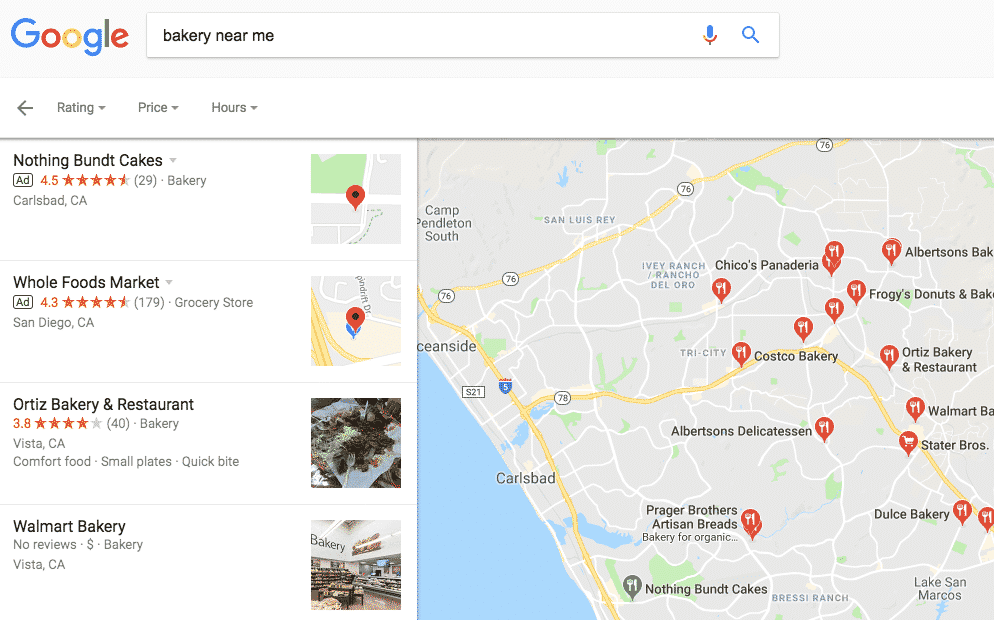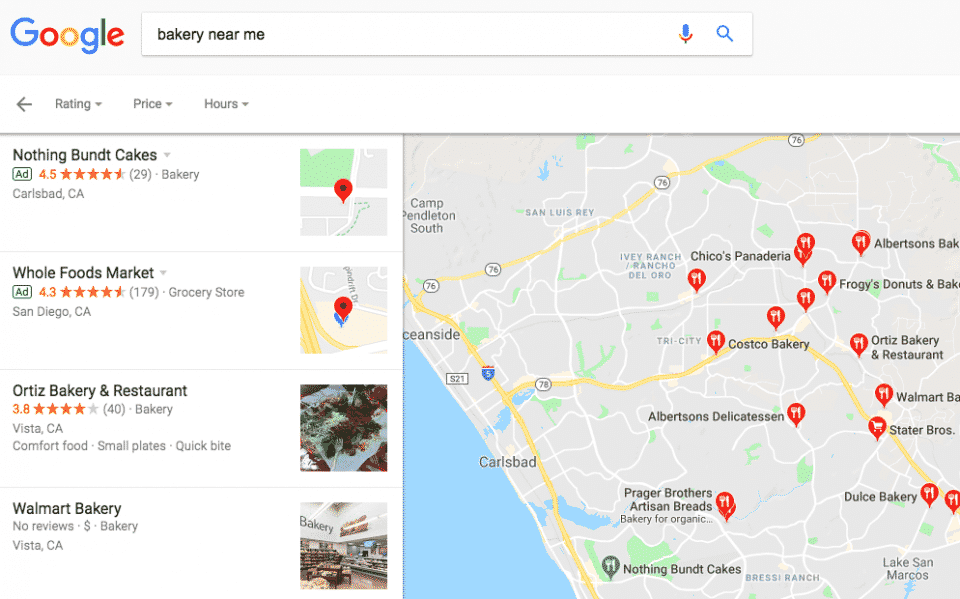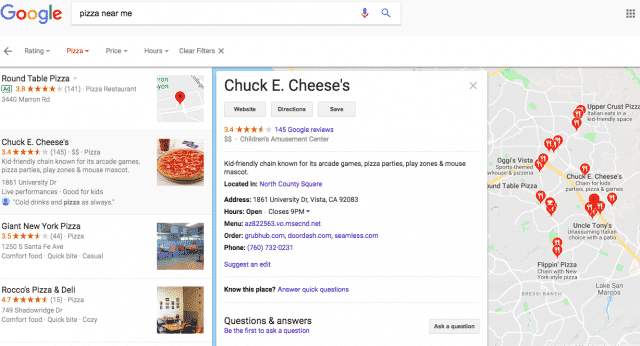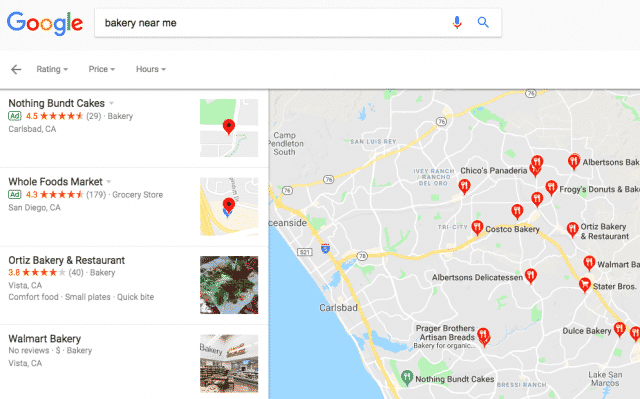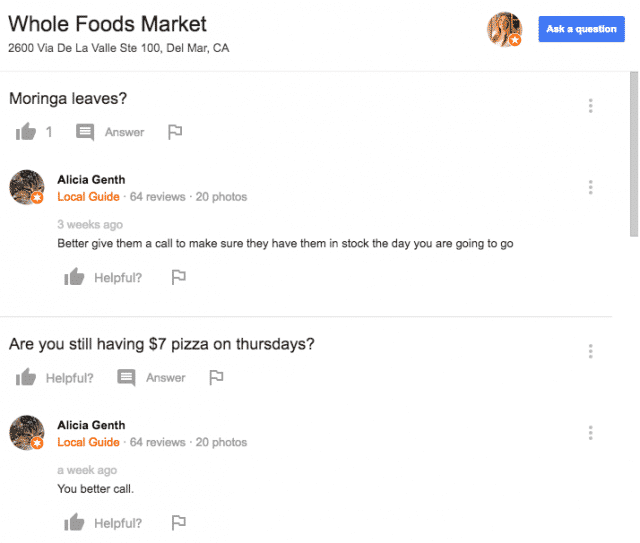Google My Business (GMB) is a tour de force when it comes to business visibility and localized SEO. Many SEO strategies and digital marketing efforts start with GMB because it drastically improves a business’ chance of getting noticed.
Not to mention, it’s just a great resource for giving potential customers a one-stop-shop for all of your frequently-searched business information (address, hours, phone number, website, customer reviews and so on).
This post will look at ways to maximize this potential value and make the most out of this resource and its offerings, while sharing some insight into the SEO potential of creating, adding to and managing a GMB listing.
What is the SEO Importance Of Google My Business Listing?
Today’s Google SERPs are loaded with snippet features, local business packs and other helpful resources that make the user’s searching experience more convenient. This means that a business can gain good, top-of-the-page visibility on Google, even if it doesn’t rank as a top result for certain keywords.
Google relies on their GMB listings to create their local business listings, flush out Google Maps and more. Having a GMB listing can even improve your organic rankings. The goal of SEO is to make your business more visible on the Internet and that’s exactly what GMB achieves.
This enhanced visibility is especially noticeable when people are conducting discovery searches. This is when a user searches a keyword term to learn more information and possibly discover local businesses.
This is different than a direct search, where a customer directly searches for your business. A discovery search could be, “bakery near me,” or “best coffee.”
In a study by Brandify, where they analyzed 6 billion searches, they found that the vast majority, 87.8%, were made with a discovery intent. This means there’s a ton of visibility to gain through these searches, if your GMB is correctly optimized to surpass your competitors.
That said, GMB is also important for direct searches too. When a user makes a direct search for a business, it’s typically to find a specific piece of information, like a phone number or address.
Google My Business perfectly encapsulates all of that information into a convenient box for your customers to find; they never even have to visit your website to have their questions answered.
Again, you can’t over emphasize the importance of this free tool, in terms of SEO and other aspects.
Tip #1: Fill Everything Out
As you create your GMB profile, Google asks a number of questions about your business. It’s important that you make the best effort to fill out every category and answer each question.
There’s two reasons for this. First, you don’t want a potential customer looking for your website or phone number and being unable to find it. Second, other people can add missing information to your GMB listing and even suggest edits. Thus, to ensure that your listing and all of its information is correct and posted by you, it is best to fill out all of the information asked.
Google has recently added a business description option that gives you 750 characters to tell your business’ story and add a little depth to your listing. This is an important place to begin plugging in your keywords.
Note: Only the first 250 characters are visible in your listing’s panel, until the user asks to see more. So, when you are crafting your business’ description, you really want to make sure that those first few sentences are informative and say everything that your customers need to know.
Tip #2: Create Posts & Add Content
After you’ve created your profile, there’s other features and content you can add to your listing. This is where you can really begin to target keywords and build the authority of your listing. You can also add pictures or videos (up to 30 seconds) of your sales floor, building or products to give people a sense of your business before they visit.
If you’re adding pictures or videos, be sure to appropriately name them. For example, instead of leaving a picture as “001.jpg,” you should rename it to something like, “SallysBakeryGAStorefront.”
Google Posts is a relatively new feature added to GMB that allows a business to add blog-like posts to their listing. One case study found a pretty strong correlation between these posts and an improved ranking.
In some cases, they were able to move several positions, with just one or two posts a week. Thus, this is a great, low-effort way to optimize your GMB and potentially raise your local SEO rankings as well.
Tip #3: Take Advantage Of Other Relevant Features
Depending on your business and industry, there may be other GMB features that can enhance your business. While utilizing these features may not improve SEO efforts, they will provide great value to users and enhance your existing customer experience.
For example, the bookings feature means an appointment-based company can allow customers to schedule a visit right through the GMB listing. These new appointments integrate with your existing scheduling software, so there’s no confusion or accidental double-bookings.
This convenience is really unmatched. Imagine a customer that searches your business for a phone number to call to schedule an appointment. Suddenly, they are booking their appointment right through your GMB listing and they’ve never had to pick up the phone.
By eliminating unnecessary steps in the scheduling process, it actually helps to encourage more people to make appointments.
Alternatively, if your business is a restaurant or service-related, adding your menu or list of available services is another important aspect of building a successful GMB.
Your business likely already gets many questions related to your menu/service offerings. Including this information on your GMB will create the opportunity for customers to answer these questions on their own and without the inconvenience of having to call and ask.
Tip #4: Communicate
A lot of user-generated content and interactions take place on the GMB platform, especially through reviews. Customers can also message a business directly or ask a question for an owner or another customer to answer.
Once you’ve created your listing, it is important to pay attention to these interactions and reply back to any reviews, questions or comments.
The more communicative you are on your listing, the more approachable your business appears. It demonstrates that you are dedicated to your customers and want to be able to serve them to the very best of your abilities.
Plus, 30% of users claim that they judge local businesses by their ability to respond to reviews and questions. It might even encourage other customers to submit questions or a review.
Tip #5: Encourage These Types Of Interactions
These interactions, especially customer reviews, are very important. It makes your listing more complete, adds to the potential keyword exposure and can make your business seem more trustworthy.
Almost all consumers today rely on online reviews, to some degree, as a way to judge a business and its practices. Many of these consumers trust a review, even by a stranger, as much as a personal recommendation.
Like the importance of creating a Google My Business listing, the importance and impact of reviews can also not be stated enough. That’s why it is good to get into the habit of asking customers to submit reviews. Many people will be pleased that you’re interested in their opinions and will happily oblige.
When your listing appears as part of the search results, a selection of reviews will appear next to your listing. The more positive reviews you can accumulate, the less likely that the inevitable negative review won’t appear next to your listing.
When you do receive a negative review, it is especially crucial that you respond and resolve the issue in a timely manner.
Consumers understand that businesses have their off days or customers can be particularly unruly. A negative review isn’t a death sentence, as long as you handle it appropriately and politely.
Tip #6: Pay Attention And Measure Results
Answering questions, replying to messages and responding to reviews should all be done in a timely manner. You don’t want a user-submitted question to be lingering for weeks or a negative review to go unchecked.
This means you want to routinely check in on your listing, make sure all of the information is still correct and respond to any new user interactions. Google does allow you to turn notifications on, so the service will alert you when there’s been a change made.
This is perhaps the best and fastest way to get notified of changes to your GMB.
Google also has a lot of helpful, data-analyzed insights about your GMB listing. Your GMB data can showcase how many new people found your business through the listing and how they arrived at that information.
Did they come from clicking your business’ pin on Google Maps or did they come right from a SERP and, if so, what search terms did they use?
By understanding how your customers are discovering your business, what sort of information they are looking for and what their next step is, you can better adjust your listing and other efforts.
These insights may provide you with key info on formulating a better keyword strategy or where you need to target your other digital marketing efforts.
Tip #7: Stay On Top
The more time you spend adjusting and improving your GMB listing, the better optimized it will be and the easier it will be to maintain a top result. The Google Local Business Pack pulls the top 3 most relevant local businesses to the user’s query.
Ranking well enough to be in this top group is very important, as these are the only three businesses that will appear, until the user clicks to see more businesses.
By frequently posting updates and responding to reviews, questions and messages, your business will begin to grow a local and loyal customer base, just as your search rankings will grow also.
